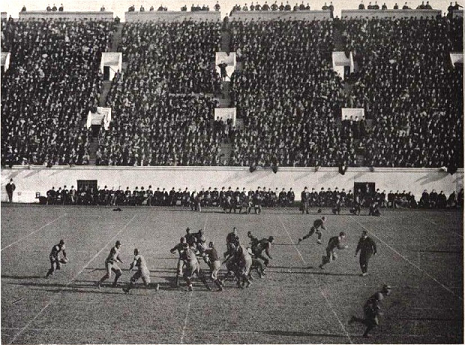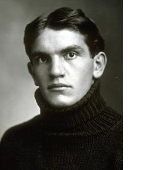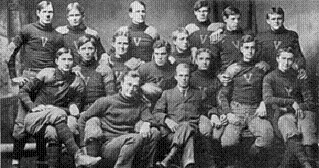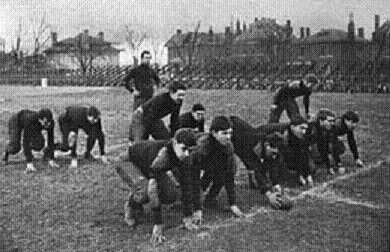 Penn 1904 featured four members of the College Football Hall of Fame, the most of any team I've covered thus far.
Penn 1904 featured four members of the College Football Hall of Fame, the most of any team I've covered thus far.One of them, however, was inducted as a coach rather than as a player. Fullback Andy Smith was a consensus All American in 1904, and was particularly strong on defense, but his greatest fame would come as coach of California's "Wonder Teams," who went unbeaten five straight seasons 1920-1924. Overall he was 116-32-13 at three schools.
Penn's best player of this decade, end Bill Hollenback (pictured), would miss the 1905 season with a broken leg, then come back as a consensus AA in 1906 and 1908 at fullback. Jim Thorpe, whose Carlisle team played Penn to a tie in 1908, called him "my greatest and toughest opponent." Hollenback played pro football and coached at Penn State, the highlight there being a 16-0-1 run 1911-1912, contending for the MNC both seasons.
Quarterback Vince Stevenson, like Andy Smith, was a consensus All American in 1904. He was small, 5' 9" and 148 pounds, but he was a great open-field runner whose specialty was hurdling would-be tacklers. I have read countless writers from the time marveling at his leaping and elusive runs with the ball. Sounds like he was fun to watch. Stevenson was also considered to be very smart, creative, and a great gameday coach (sideline coaches were not allowed to call the plays at that time). He was especially adept at dissecting and outguessing opposing offenses.
The fourth Hall of Famer was center and captain Bob Torrey, a consensus AA in 1905. A great defensive player, Torrey is credited by most older sources as the first "roving center," a center that played back off the line on defense (the original middle linebacker). This later became standard for most college football teams. However, later sources, and modern ones such as wikipedia, credit Michigan center Germany Schulz (who will be introduced as a freshman below) with inventing the roving center. But this is just another example of Michigan successfully rewriting history, as Torrey was roving before Schulz even enrolled at Ann Arbor.
There were actually two other Hall of Famers on this team. Guard Frank Piekarski, Penn's third consensus AA in 1904, is in the Polish-American Sports Hall of Fame, and was the first Polish All American. He scored 3 touchdowns in a 34-0 season-ending win over Cornell. End Garfield Weede, a non-consensus All American, saw his season end with a broken leg against Gettysburg. He is in the Kansas Sports Hall of Fame as a player and coach, going 70-37-10 at Washburn and Pittsburgh colleges in Kansas.


 Adolph
"Germany" Schulz is considered the greatest center of his time, and a
1951 National Football Foundation poll named him the greatest center of
all time. He is credited with inventing the spiral snap and the roving
center (as was Penn's Bob Torrey, as noted above). Very big and fast,
he was tremendous on defense and kick coverage. He was also dogged by
controversy throughout his career at Michigan, and newspapers continued
digging up stories for a few years after he had left the school.
Adolph
"Germany" Schulz is considered the greatest center of his time, and a
1951 National Football Foundation poll named him the greatest center of
all time. He is credited with inventing the spiral snap and the roving
center (as was Penn's Bob Torrey, as noted above). Very big and fast,
he was tremendous on defense and kick coverage. He was also dogged by
controversy throughout his career at Michigan, and newspapers continued
digging up stories for a few years after he had left the school.
